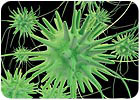A "Killer" Paint
Researchers at the Massachusetts Institute of Technology (MIT) have developed an “antimicrobial paint” that can kill influenza viruses that land on surfaces coated with it, potentially offering a new weapon in the battle against a disease that kills nearly 40,000 Americans per year.

Researchers at the Massachusetts Institute of Technology (MIT) have developed an “antimicrobial paint” that can kill influenza viruses that land on surfaces coated with it, potentially offering a new weapon in the battle against a disease that kills nearly 40,000 Americans per year. If applied to doorknobs or other surfaces where germs tend to accumulate, the new substance could help fight the spread of the flu, says Jianzhu Chen, MIT professor of biology.
Influenza is spread when viruses released by an infected person accumulate on surfaces, where other people pick them up. Stopping the viruses before they infect people could prevent some flu cases, says Chen. The new substance can do just that, by killing influenza viruses before they infect new hosts. The “antimicrobial paint,” which can be sprayed or brushed onto surfaces, consists of spiky polymers that poke holes in the membranes that surround influenza viruses.
Influenza viruses exposed to the polymer coating were essentially wiped out. The researchers observed a more than 10,000-fold drop in the number of viruses on surfaces coated with the substance, according to Alexander Klibanov, MIT professor of chemistry and bioengineering.
The polymers are also effective against many types of bacteria, including deadly strains of the human pathogens Escherichia coli and Staphylococcus aureus. Bacteria can become resistant to traditional antibiotics by adjusting the biochemical pathways targeted by antibiotics, but it would be difficult for bacteria to evolve a way to stop the polymer spikes from tearing holes in their membranes.
“It’s hard to develop resistance to someone sticking a knife in your body,” Klibanov said.
In a prior experiment designed to test for resistance, 99% of bacteria that were exposed to a polymer-coated surface died. The researchers then took the surviving 1%, let them multiply and again exposed them to the surface. They repeated the cycle 12 times, and each time, approximately 99% of the bacteria were killed, suggesting that the microbes were not becoming resistant.
The MIT researchers are working with industrial and military partners such as Boeing and the Natick Army Research Center to develop the coatings for practical use.
Once the polymer coating is applied to a surface, it should last about as long as a regular coat of paint, Klibanov said. Accumulation of dead bacteria and viruses diminishes the effectiveness of the nanometer-sized polymer spikes, so the surface would need to be washed with soapy water every once in a while to remove dead microbes, he said.
The research is funded by the U.S. Army, through MIT’s Institute for Soldier Nanotechnologies, and also by the National Institutes of Health.

An artist's rendering of a virus.
Researchers at the Massachusetts Institute of Technology (MIT) have developed an “antimicrobial paint” that can kill influenza viruses that land on surfaces coated with it, potentially offering a new weapon in the battle against a disease that kills nearly 40,000 Americans per year. If applied to doorknobs or other surfaces where germs tend to accumulate, the new substance could help fight the spread of the flu, says Jianzhu Chen, MIT professor of biology.
Influenza is spread when viruses released by an infected person accumulate on surfaces, where other people pick them up. Stopping the viruses before they infect people could prevent some flu cases, says Chen. The new substance can do just that, by killing influenza viruses before they infect new hosts. The “antimicrobial paint,” which can be sprayed or brushed onto surfaces, consists of spiky polymers that poke holes in the membranes that surround influenza viruses.
Influenza viruses exposed to the polymer coating were essentially wiped out. The researchers observed a more than 10,000-fold drop in the number of viruses on surfaces coated with the substance, according to Alexander Klibanov, MIT professor of chemistry and bioengineering.
The polymers are also effective against many types of bacteria, including deadly strains of the human pathogens Escherichia coli and Staphylococcus aureus. Bacteria can become resistant to traditional antibiotics by adjusting the biochemical pathways targeted by antibiotics, but it would be difficult for bacteria to evolve a way to stop the polymer spikes from tearing holes in their membranes.
“It’s hard to develop resistance to someone sticking a knife in your body,” Klibanov said.
In a prior experiment designed to test for resistance, 99% of bacteria that were exposed to a polymer-coated surface died. The researchers then took the surviving 1%, let them multiply and again exposed them to the surface. They repeated the cycle 12 times, and each time, approximately 99% of the bacteria were killed, suggesting that the microbes were not becoming resistant.
The MIT researchers are working with industrial and military partners such as Boeing and the Natick Army Research Center to develop the coatings for practical use.
Once the polymer coating is applied to a surface, it should last about as long as a regular coat of paint, Klibanov said. Accumulation of dead bacteria and viruses diminishes the effectiveness of the nanometer-sized polymer spikes, so the surface would need to be washed with soapy water every once in a while to remove dead microbes, he said.
The research is funded by the U.S. Army, through MIT’s Institute for Soldier Nanotechnologies, and also by the National Institutes of Health.
Looking for a reprint of this article?
From high-res PDFs to custom plaques, order your copy today!




